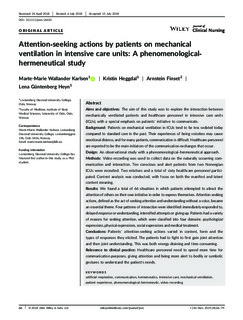| dc.contributor.author | Karlsen, Marte-Marie Wallander | |
| dc.contributor.author | Heggdal, Kristin | |
| dc.contributor.author | Finset, Arnstein | |
| dc.contributor.author | Heyn, Lena | |
| dc.date.accessioned | 2019-04-05T11:27:58Z | |
| dc.date.available | 2019-04-05T11:27:58Z | |
| dc.date.created | 2018-08-16T13:35:52Z | |
| dc.date.issued | 2018 | |
| dc.identifier.citation | Journal of Clinical Nursing. 2018, 1-14. | |
| dc.identifier.issn | 0962-1067 | |
| dc.identifier.uri | http://hdl.handle.net/11250/2593514 | |
| dc.description.abstract | Aims and objectives The aim of this study was to explore the interaction between mechanically ventilated patients and healthcare personnel in intensive care units, with a special emphasis on patients’ initiative to communicate. Background Patients on mechanical ventilation in intensive care units tend to be less sedated today compared to standard care in the past. Their experiences of being voiceless may cause emotional distress, and for many patients, communication is difficult. Healthcare personnel are reported to be the main initiators of the communication exchanges that occur. Design An observational study with a phenomenological–hermeneutical approach. Methods Video recording was used to collect data on the naturally occurring communication and interaction. Ten conscious and alert patients from two Norwegian intensive care units were recruited. Two relatives and a total of sixty healthcare personnel participated. Content analysis was conducted, with focus on both the manifest and latent content meaning. Results We found a total of 66 situations in which patients attempted to attract the attention of others on their own initiative in order to express themselves. Attention‐seeking actions, defined as the act of seeking attention and understanding without a voice, became an essential theme. Four patterns of interaction were identified: immediately responded to, delayed response or understanding, intensified attempts, or giving up. Patients had a variety of reasons for seeking attention, which were classified into four domains: psychological expressions, physical expressions, social expressions, and medical treatment. Conclusions Patients’ attention‐seeking actions varied in content, form, and the types of responses they elicited. The patients had to fight to first gain joint attention and then joint understanding. This was both energy draining and time consuming. Relevance to clinical practice Healthcare personnel need to spend more time for communication purposes, giving attention and being more alert to bodily or symbolic gestures to understand the patient's needs. | |
| dc.description.abstract | Attention‐seeking actions by patients on mechanical ventilation in intensive care units: A qualitative study | |
| dc.language.iso | eng | |
| dc.rights | Attribution-NonCommercial-NoDerivatives 4.0 Internasjonal | * |
| dc.rights.uri | https://creativecommons.org/licenses/by-nc-nd/4.0/ | * |
| dc.title | Attention‐seeking actions by patients on mechanical ventilation in intensive care units: A qualitative study | |
| dc.type | Peer reviewed | |
| dc.type | Journal article | |
| dc.description.version | publishedVersion | |
| dc.source.pagenumber | 1-14 | |
| dc.source.journal | Journal of Clinical Nursing | |
| dc.identifier.doi | 10.1111/jocn.14633 | |
| dc.identifier.cristin | 1602436 | |
| cristin.ispublished | true | |
| cristin.fulltext | original | |
| cristin.qualitycode | 2 | |

